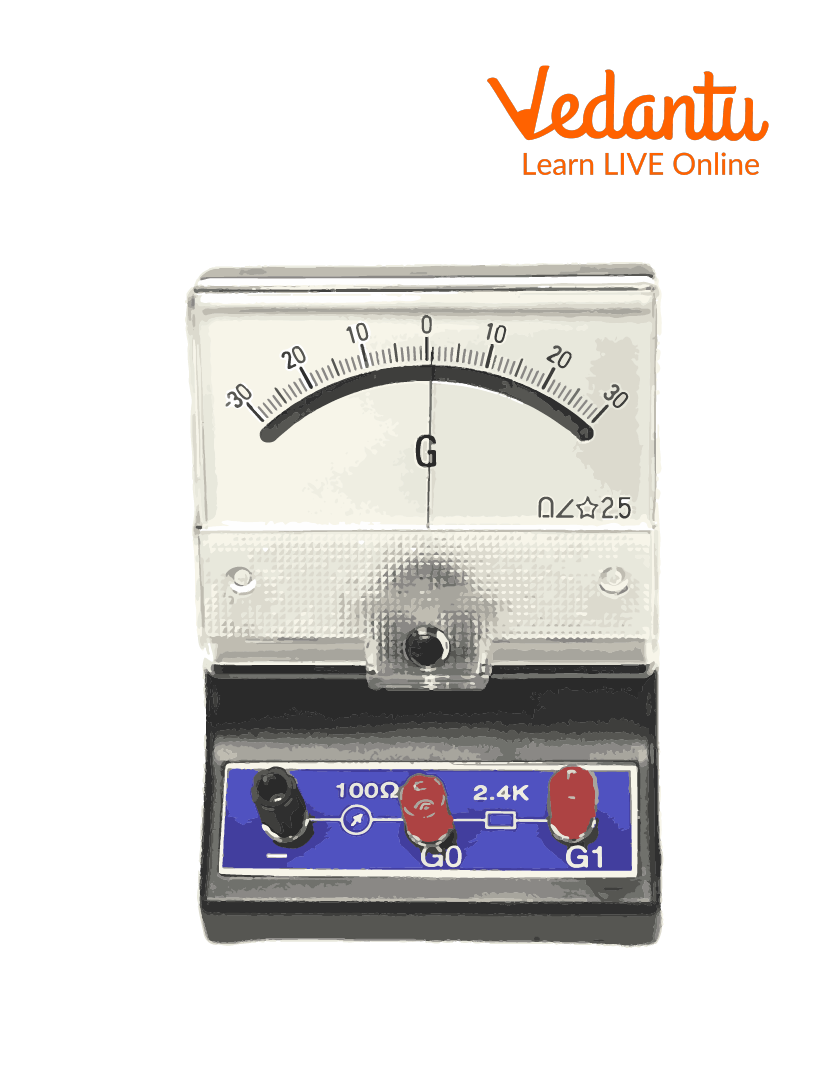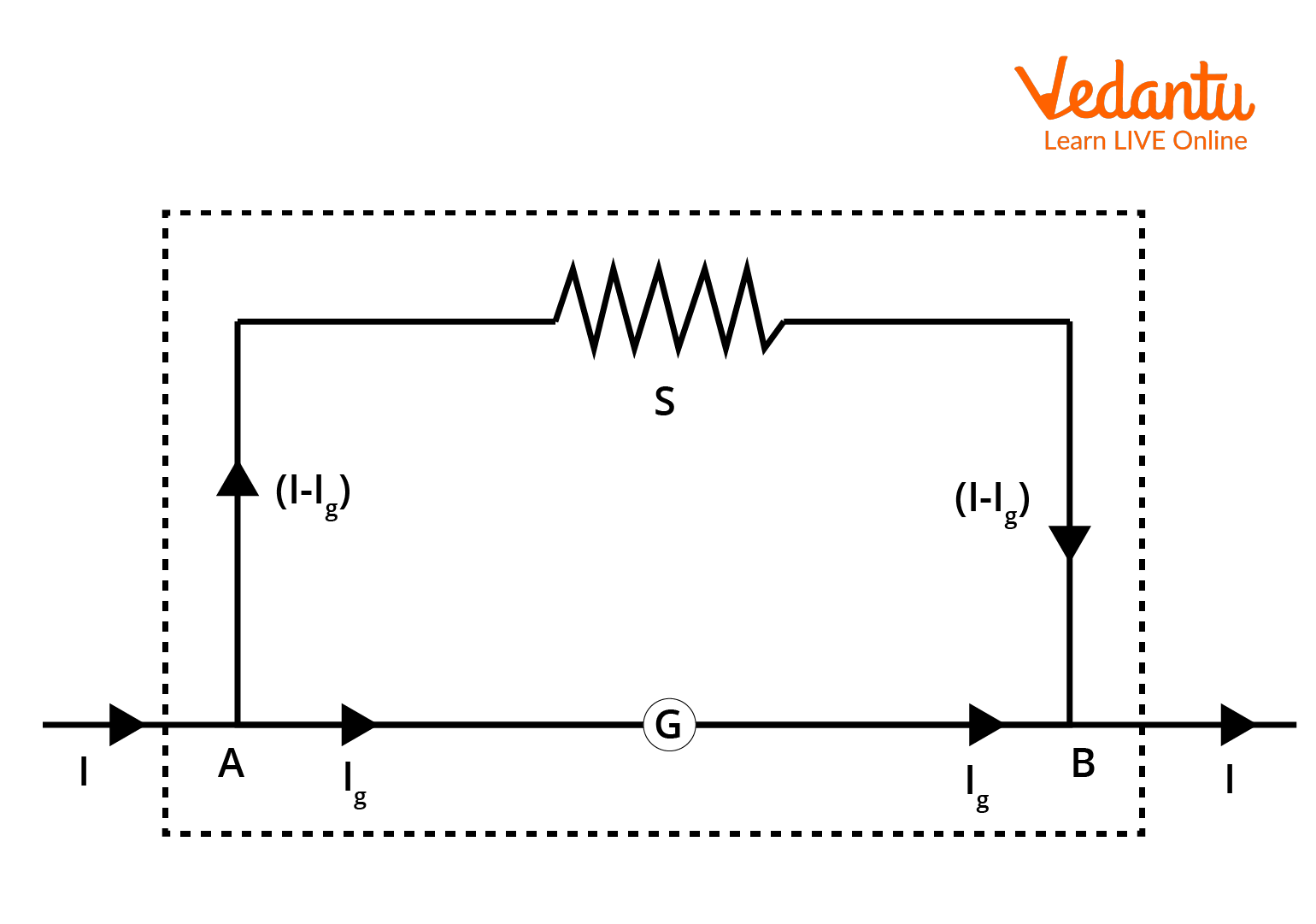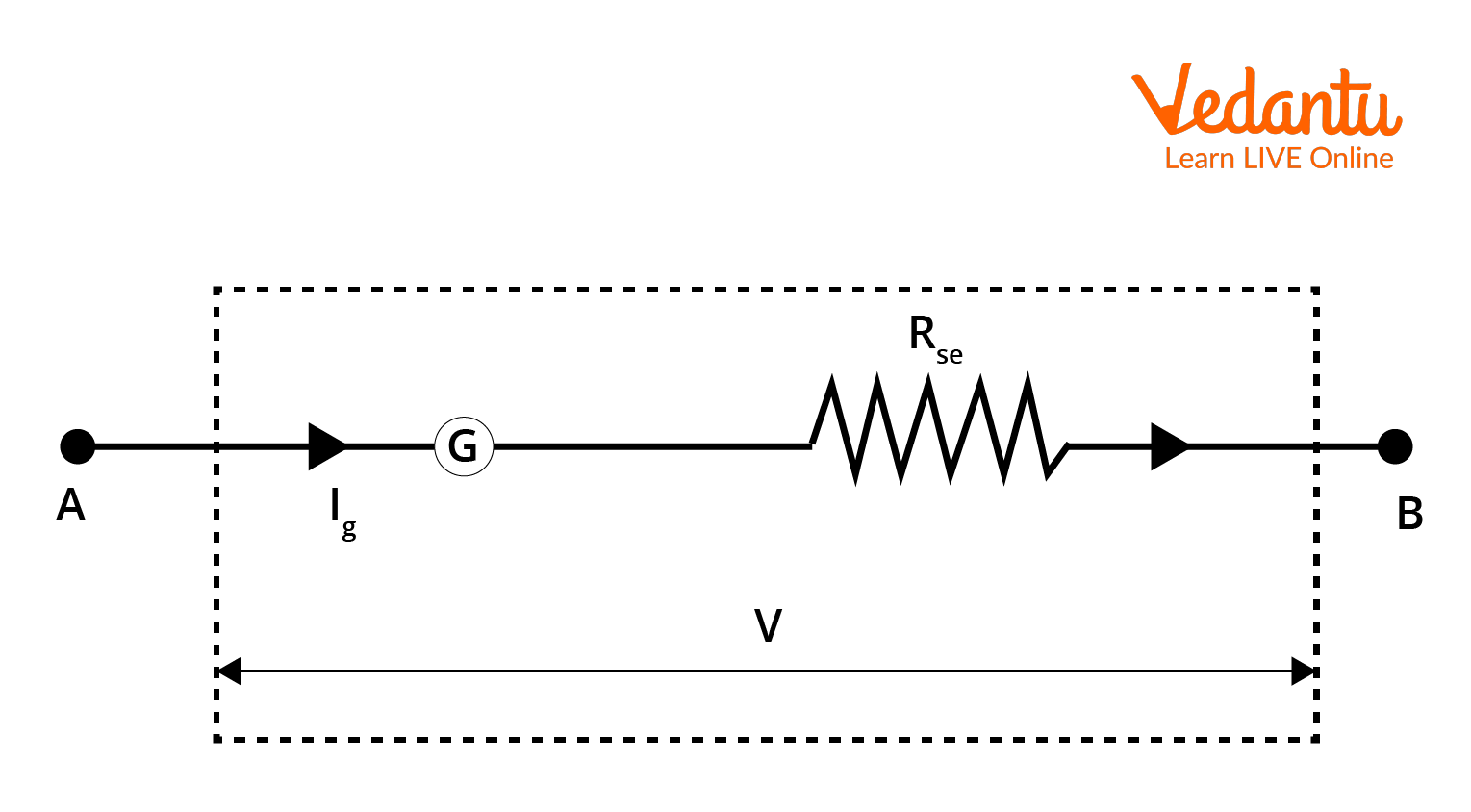




Understanding the Conversion of a Galvanometer into an Ammeter and Voltmeter: Step-by-Step Process and Applications
A galvanometer is an instrument that is used in the detection of small currents in an electric circuit. The conversion of galvanometer to ammeter and voltmeter respectively can easily be achieved by adding resistance in series or in shunt. But why do we require the conversion of a galvanometer into an ammeter and voltmeter? As mentioned earlier, a galvanometer is an instrument used to measure small electric currents. To measure high currents and high potential differences in an electric circuit, galvanometers are usually converted to ammeter or voltmeters depending on the required usage. This is very important for solving problems in JEE Main exam.
What is a Galvanometer?
A galvanometer is a device or an instrument that is used to measure small currents in an electric circuit. It can be used as both ammeter and voltmeter by adding resistance to it in parallel or series. A galvanometer consists of a coil which is placed between the poles of a horseshoe magnet. When an electric current passes through this coil, the pointer of the galvanometer deflects. Most popular and frequently used galvanometer today is the D’Arsonal type.

A Galvanometer
How to Convert Galvanometer Into Ammeter
To convert a galvanometer into an ammeter, a shunt resistor is added in parallel with the galvanometer. This allows the ammeter to measure larger currents without damaging the galvanometer.
Steps to Convert:
Step 1: Determine the full-scale deflection current: This is the maximum current the galvanometer can safely measure.
Step 2: Choose a suitable shunt resistor: The value of the shunt resistor $R_s$ is calculated using the formula: $R_s = \dfrac{G}{I - G}$ Where:
G is the internal resistance of the galvanometer.
I is the maximum current to be measured by the ammeter.
Step 3: Connect the shunt resistor: The shunt resistor is connected in parallel with the galvanometer, allowing most of the current to bypass the galvanometer and flow through the shunt resistor.
Galvanometer to Ammeter Formula
The conversion of a galvanometer into an ammeter and a voltmeter is achieved by adding a resistor of a particular value in series or in parallel. A galvanometer can only measure small currents. Thus, for it to measure large currents, we convert it into an ammeter by connecting a resistor in parallel. Ammeter, as we know, is an instrument used to measure the value of current. The ammeter must have low resistance, so that the current passing through it does not change. A low resistance value is connected in the shunt, so that the overall current passing through the ammeter does not change.

Conversion of Galvanometer to Ammeter
The value of shunt S can be calculated using the circuit above. G is the resistance of the galvanometer, Ig is the current through the galvanometer, I is the total current through the circuit and (I-Ig) is the current passing through the shunt resistor (S).
Now, for a parallel circuit we know that the potential difference is equal. Thus, we get:
$\begin{align} &{I_g} \times G=(I-{I_ g}) S \\ &\therefore S=\dfrac{{I_ g} G}{I-{I_ g}} \end{align}$
or
$S=G\left(\frac{I_g}{I-I_g}\right)$
Further,
$\begin{align} &S \times I=G \times I g+S \times I g \\ &\Rightarrow S \times I={I_g}(G+S) \\ &\Rightarrow I={I_g}\left(\dfrac{G+S}{S}\right) \\ &\text { or } \\ &\Rightarrow I={I_ g}\left(1+\dfrac{G}{S}\right) \end{align}$
It can be further re-written as: $\Rightarrow {I_ g}=I\left(\dfrac{S}{G+S}\right)$
Now, if $\theta$ is assumed to be the deflection in the galvanometer, then it can be denoted as:
$\theta \propto {I_ g}$
$\theta \propto {I_ g}. m$, where $m=\dfrac{I}{I_g}$
$\theta \propto {I_ g} \cdot \dfrac{I}{I_g}$
$\theta \propto I$
Thus, deflection in the galvanometer is equal to the current passing through it. Additionally, the value of shunt resistance will be in milliohms.
How to Convert Galvanometer Into Voltmeter?
Since it is a very sensitive instrument, a galvanometer cannot measure high voltages or potential difference. Thus, to overcome this, we convert a galvanometer to a voltmeter.

Conversion of Galvanometer to Voltmeter
Voltmeter, as we know, is used to measure the potential difference between any two points in an electric circuit. The current passing through the galvanometer must be equal to the total current in a circuit, as the difference will cause a change in the potential difference. Thus, we connect a high resistance in series with a galvanometer.
Galvanometer to Voltmeter Formula Formula
Assuming Ig as the value of galvanometer, V is the potential difference or emf between point A and B, Rse is the series resistance connected to galvanometer and $\theta$ is the deflection in the galvanometer. Also, Rg is the resistance of the galvanometer and Vm is the voltage across Rse.
As it is a series circuit, I=Ig.
$I_g=\dfrac{V}{R_{se}+R_g}$
Thus, $I_g\propto V$, which means that the deflection in the galvanometer depends on the potential difference across any two points in the circuit.
Further,
$\begin{align} &\dfrac{V}{R_g}=\dfrac{(V-V_m)}{R_{se}} \\ &\dfrac{R_{se}}{R_g}=\dfrac{V-V_m}{V} \\ &\therefore \dfrac{V}{V_m}=\left(1+\dfrac{R_{s e}}{R_g}\right) \\ &\Lambda l s o, m=\dfrac{V}{V_m} \\ &\therefore m-1=\dfrac{R_{s e}}{R_ g} \end{align}$
The value of Rse or series resistor will be in kiloohms ($k\Omega$). Also, the scale of the galvanometer will now be in volts and its range will depend on the value of resistance connected in series.
Conclusion
The article presents a thorough overview of how a galvanometer is converted to an ammeter and a voltmeter respectively. Being a sensitive device, a galvanometer can only measure feeble currents in the circuit. Thus, to extend its range, we use resistors in series and in parallel, to control the flow of current through the galvanometer. Also, the branches of resistors to be connected depends on how much the range of ammeter or voltmeter is to be increased. To increase the range of ammeter n times, the value of shunt resistor to be used is $S=\dfrac{G}{n-1}$, whereas for the voltmeter, it will be $R=(n-1) \cdot G$.
JEE Main 2025 Subject-Wise Important Chapters
The JEE Main 2025 subject-wise important chapters provide a focused strategy for Chemistry, Physics, and Maths. These chapters help students prioritise their preparation, ensuring they cover high-weightage topics for better performance in the exam.
Check Other Important Links for JEE Main 2025
Get essential study materials for JEE preparation, including notes, sample papers, and important questions for both JEE Main and JEE Advanced. These resources cover everything from formulas to mock tests, helping you strengthen your understanding and practice effectively. Use these links to boost your confidence and excel in your exams.
FAQs on JEE Main 2025: Conversion of Galvanometer Into Ammeter And Voltmeter in Physics
1. What are D'Arsonval and moving magnet galvanometers?
D'Arsonval galvanometer is also known as moving coil galvanometer. Moving coil galvanometer is a very sensitive instrument used to measure feeble currents of the order of $10^{-9}$. It consists of a coil, and the deflection in this galvanometer is dependent on the amount of current passing through it.
Moving magnet on the other hand is a type of galvanometer that is dependent on the movement of a small magnet. The magnet is essentially a permanent magnet placed in a magnet field, and its movement is dependent on the amount of current passing through it.
2. What is the material used for the coil of the galvanometer?
The coil in a galvanometer is a current carrying part of it. A thin copper insulated wire is used as a coil in a galvanometer. The coil used may be rectangular or circular, and is wound with a number of turns. For example, modern galvanometers like D'Arsonval are constructed with a small pivoting coil of wire. It is called a spindle and is placed in a magnetic field. The coil is further attached to a pointer that traverses over a calibrated scale to provide the measured value.
3. What is the conversion of a galvanometer into an ammeter?
A galvanometer can be converted into an ammeter by connecting a low-resistance shunt resistor in parallel with it. This allows the device to measure higher currents by bypassing most of the current through the shunt.
4. How is a galvanometer converted into a voltmeter?
A galvanometer can be converted into a voltmeter by connecting a high-resistance series resistor in series with it. This limits the current flowing through the galvanometer, allowing it to measure higher voltages.
5. Why is a shunt resistor used in converting a galvanometer into an ammeter?
The shunt resistor is used to divert most of the current away from the galvanometer, allowing it to measure a higher current without exceeding its current limit.
6. What type of resistor is used to convert a galvanometer into a voltmeter?
A series resistor is used when converting a galvanometer into a voltmeter. This resistor ensures that only a small portion of the current flows through the galvanometer, enabling it to measure higher voltages.
7. How do you calculate the shunt resistor for the ammeter?
The value of the shunt resistor $R_s$ is calculated using the formula:
$R_s = \frac{G}{I - G}$
Where G is the internal resistance of the galvanometer, and I is the maximum current to be measured.
8. How do you calculate the series resistor for the voltmeter?
The series resistor $R_s$ is calculated based on the voltage range you wish to measure and the full-scale deflection of the galvanometer. It ensures that the current flowing through the galvanometer remains safe for measurement.
9. What happens if the wrong type of resistor is used in the conversion?
Using the wrong type or incorrect value of the resistor can damage the galvanometer or lead to inaccurate readings. For instance, if the shunt resistor is too small, it can overload the galvanometer, and if the series resistor is too large, it may prevent the galvanometer from deflecting properly.
10. Can a galvanometer measure both current and voltage after conversion?
Yes, after conversion, the galvanometer can either measure current (as an ammeter) or voltage (as a voltmeter), depending on whether a shunt resistor or series resistor is used.
11. What is the role of the galvanometer in these conversions?
The galvanometer provides a small, sensitive scale for measuring electrical quantities. In both conversions, it acts as the core measurement device, with the additional resistors allowing it to measure larger currents or voltages.
12. Is it possible to convert a galvanometer into a digital ammeter or voltmeter?
While a traditional galvanometer is an analogue device, converting it into a digital ammeter or voltmeter would require additional digital components such as an analogue-to-digital converter (ADC), in addition to the shunt or series resistors.



































